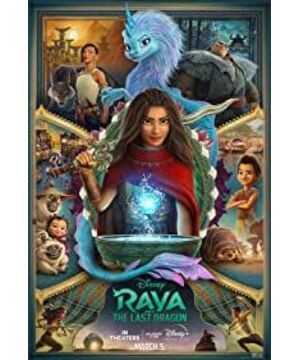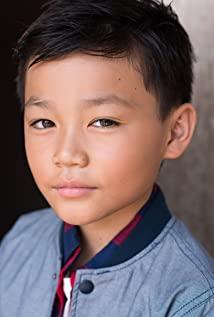"Legend of the Dragon" has a very confusing beginning of the movie:
In an ancient land, the originally harmonious humans lost trust in each other in order to compete for the mysterious magical dragon gemstone. They split into five tribes, each raising a large number of mercenaries, warriors and assassins, doing it anytime, anywhere. Well prepared for war. The father of the heroine Raya, the guardian of the dragon jewel, the leader of the Dragon Heart City, a powerful warrior who can dance and fight, is so strong that the enemy can't even get close to the jewel with his toes. He hoped to call on all tribes to stop wars, maintain peace, trust each other, and rebuild this ancient land of prosperity and unity.
Raya asked him what he planned to do, and he said:
"Let's have a meal together."
While saying this, his father showed Raya his latest recipe in a large kitchen full of servants, just like a loving father in every Asian culture: even though he was knowledgeable and successful, he still Keeping hobbies like cooking, I can cook fatherly dishes that will be unforgettable for children throughout their lives. He put a spoonful of shrimp paste, a handful of lemongrass, a plate of bamboo shoots, a bit of chili and palm sugar into a large soup pot, looking at the bowl of red soup with weird condiments, Raya thought his father would give it to him. Other tribes poisoned them and couldn't help but greet them with a sip before discovering:
original! Drinking Tom Yum Goong soup also has the effect of national unity!
"Legend of the Dragon" is a Disney animated feature inspired by Southeast Asian culture. Since the first animated feature film "Snow White and the Seven Dwarfs" was released in 1937, Disney has continued to release new works at a rate of nearly one per year. Until the current "Legend of the Dragon", it is already the 59th animated feature film. . Disney’s animation has a notable feature, that is, all plots take place in the overhead world, and the fantasy world takes place in front of the audience in the form of animation. The civilization of the overhead world is often rooted in the real world. Taking "Big Hero 6" as an example, the conceptual city "San Fransokyo" presented in the film combines the urban cultural backgrounds of San Francisco and Tokyo, allowing the audience It feels both fresh and familiar.
The director of "Big Hero 6", Don Hall, is also the director of "The Legend of the Dragon". Judging from the details of the costumes, architecture, art design and cooking ingredients presented in "The Legend of the Dragon", the film draws on the cultures of Southeast Asian countries such as Laos, Indonesia, Thailand, Vietnam, Cambodia, Malaysia, and Singapore. It is not easy to present a movie with a strong Asian cultural flavor in a Western context, even if the art director can learn the characteristics of Asian culture and control the art style, choose a few Asian-featured musical instruments in the music arrangement In the arrangement, if the core of the plot of the characters still follows the established ideas of the Western cultural context, the final work is likely to be just a representation of painting a gourd in the same way. Cultural expression is sometimes similar to cooking, and the flamboyant presentation may evoke the desire of the audience to find out, but it depends on whether the food is delicious or not, and it must be cultural.
Starting from a bowl of Tom Yum Goong soup, "The Legend of Finding the Dragon" unfolded its attempt to let the culture taste in the aerial world of animation. This may be the most obsessive about eating among so many Disney feature-length animations, just like the passion of Southeast Asian nations for food. People in Southeast Asia love to eat bananas. In some countries, bananas are not only fruits, but can also be used as a unit of measurement. In the past, bananas were printed on Malaysian banknotes. In Vietnamese local proverbs, there is "learn to eat first to learn a language." One said. Like China, Vietnamese people like to say "have you eaten?" The line that appears most frequently in the movie "Legend of the Dragon", in addition to highlighting the core theme of this article "trust each other", is the sentence "Who is hungry?" This sentence replaces "How are you?" "Make a friend" "All the subtexts that break the deadlock and promote the development of the relationship between the characters seem to be going to eat, but in fact it means something. This kind of behavior is collectively called "dining" in Asian culture. From this perspective, it is not difficult to understand that the guardian of the movie title God Dragon Jewels, in order to unify the kingdom of Dragon Blessing, hopes to invite everyone to have a meal. If there is a problem that cannot be solved by a meal, then two pause.
But when the enjoyment of a dinner is placed in front of the other four tribes that are hostile to Dragon Heart City, everyone without exception regards it as a "Hongmen Banquet", which is complicated in the context of Asian culture. The meaning unfolds: in European and American cultural works, there are few plots that give complex definitions to banquets. Only Leonardo’s "Last Supper" has been used since the Renaissance to refer to "betrayal" and has been used in various cultural works in Europe and America. among. However, in Asian cultural works, the creators are all worthy of scrutiny about what banquet, what to eat, and how to eat, and a professional actor even has different levels of performance for "eating drama".
In the movie "Lover" with a Vietnamese background, there is a classic scene of eating in a high-end restaurant. The heroine invites her older lover to have dinner with her family in order to show her family Show off the rich business lovers she captured; the lover tried her best to win everyone’s favor during the dinner, and in the end only the huge pile of money that was taken out at the checkout attracted the attention of the family; her family pretended to be indifferent to the lover , But in my heart was thinking about how to profit from him. In movies with Asian cultural background, eating is often used as a bond or an important turning point in a relationship
Raya's father invited the four tribes to dinner and reconciliation, but the four tribes questioned his attempt. Raya tried to help her father to break the siege and took the initiative to walk in front of everyone to break the stalemate. Just when everyone thought Raya was going to defend her father, she asked everyone: "Who is hungry?" Language can be transformed into splitting the tribe. A weapon of unity, but food is always neutral and will not be biased towards any power. The various tribes looked at each other, and Namali, the daughter of the leader of Longyagu, took the initiative to stand up.
During the banquet, it depends on whether a person wants to do business or sincerely wants to eat. Just look at the person's attitude towards the things in front of you, and you can guess how many things. The camera turned to Raya and Namali. The two girls sat on the ground chatting. The food beside Namali remained unchanged, while Raya was left with only one skewers on the dinner plate. Raya divided the meat skewers into half of Namali. The two exchanged girl’s thoughts. Through a quick question and answer about food, Namali took the initiative to talk about the legend of the last dragon Xisu. . Raya excitedly took Namali to see the dragon gems that Dragon Heart City had guarded for generations, and shared her proud secrets with her friends just like she shared meat skewers.
Just like this meal that didn't finish well, with Namali's betrayal, the friendship between the two girls was torn apart.
After becoming an adult, Raya took her pet to find the dragon Xisu. In the cave where the wreckage was piled up, Raya successfully awakened Xisu. The first thing Xisu did after waking up was to learn from Raya. I took the jackfruit in my bag and ate it. Dried jackfruit is a typical Vietnamese dried fruit snack. Sisu who stole the snacks broke Raya and the audience’s holy imagination of Shenlong’s original supremacy. It became Raya’s companion just like a small child next door. . Therefore, even if Sisu becomes stronger and stronger after gaining the magic power of all parties, Raya always guards it more like a big sister in front of Sisu, fearing that it will be deceived by the human world.
When dealing with dining scenes, Western movies seldom pay attention to the food itself, nor do they give food a specific emotional sustenance. The director used the food characteristics of various parts of Southeast Asia to shape the different food plots in "The Legend of the Dragon". When Raya and Sisu fled to the boat of the little boy Apo, the three were initially in an employment relationship in the midst of a money transaction. Raya did not trust Apo, let Xisu hide his identity as a dragon. Apo brought out a pot of shrimp porridge and asked them to taste it, but Raya refused. She thinks that the porridge may be poisonous—just like the plot of any Asian martial arts film, when an innkeeper who sees money is open to serve the knights with food for no reason, it is more or less unkind. Apo told Raya: "Even if this porridge is poisonous, you will die happily after drinking it." Xisu, who was on the side, had already drunk a whole bowl of porridge and sighed with happiness.
What can someone who cooks deliciously be wicked? This is an eternal truth in Asian culture. It's hard not to have a strong sense of dependence and favor on someone who does a good job. Childhood trauma made Raya no longer trust anyone easily, but Apo easily used a pot of good porridge to win Raya's trust. Tom Yum Goong soup became a symbol of uniting the five races in his father's hands, while Apo's shrimp porridge served as a way to build trust. In the subsequent adventures, whenever there is one more passenger on the ship, the scene of everyone drinking shrimp porridge together will be repeated, emphasizing that food is the bond of unity.
When a group of people on the boat arrived at Longji Mountain, Zhenzhen Xisu was unwilling to ask the leader of Longji Mountain for the fragments of Shenlong gemstones by "sending a meeting gift", so he grabbed a pot of shrimp porridge and rushed into the deep mountain bamboo forest. She held the shrimp porridge and told Raya, "If you want to trust others, you must first let others trust you." Then she knocked on the door knocker of the Longji Hill Tribe, like an enthusiastic neighbor holding a pot of freshly cooked dumplings. Give it to everyone to taste the same.
As Raya expected, they were caught by a trap. Sisu wanted to resolve the embarrassment caused by his sloppyness, but was unwilling to admit that his thoughts were wrong, so he pretended to ask, "Is anyone hungry?"
Southeast Asian movies have a strong fascination with tropical fruits. Tropical fruits are nourished by the same terroir like Southeast Asians. It is often used by Southeast Asian directors as a symbol to refer to the artistic conception between people. There is the green papaya in "The Taste of Green Papaya", and the durian in "Tropical Rain". The tropical fruit symbol used in "The Legend of the Dragon" is the dried jackfruit that Raya carries with him and the old vine of Longji Mountain Warriors. Mango. Jackfruit is dried to Raya, it is a food with hometown color. It is also hard and hard to satisfy the appetite, just like she spent six years of asceticism in search of Hesu. Lao Teng, who had lost his family, lonely guarded the fragments of the dragon crystal. When he caught Sisu and Raya, he could not hide his excitement of seeing humans again for many years, but he did not directly say it, but told Sisu : "You smell like mango."
"Only idiots who don't have a tongue don't love mango." Lao Teng added.
Everyone admires Xisu, because she is the legendary dragon who saved the kingdom of Longyou. People admire not only the dragon itself, but also the powerful magic possessed by the dragon. Lao Teng thinks Xisu is like a mango. Love the arrival of Sisu and Raya like the most missed food in a lonely life. It's hard to imagine that the most romantic line in this article was actually spoken by a tall and powerful lone warrior who lived in a deep mountain and old forest playing with his two-handed axe.
Before heading to Dragon Tooth Valley and fighting for the last gem fragment, Raya had a reunion dinner with Sisu and their friends. This seems like a practice, because everyone knows that this is the last stop in the entire adventure and the most difficult one. The recapture of the Dragon's Fragment in Dragon Tooth Valley is of extraordinary significance to everyone. Everyone hopes that Xisu can repair the Dragon's gems, so that relatives can return, and the evil forces can disappear forever from the kingdom of Dragon Blessing. Raya used to go her own way, but now she has friends from various tribes in the Longyou Kingdom Continent to fight alongside her. At the practice banquet, Raya re-made the bowl of Tom Yum Goong soup that her father had made in her childhood. At this time, after experiencing so much, she can understand more deeply why a bowl of soup and ingredients from various tribes can make a bowl of delicious dishes.
This is the first and last dish that appeared in "The Legend of the Dragon".
In addition to the dazzling tropical fruits and Southeast Asian cuisine, the art setting of Southeast Asian culture in "The Legend of the Dragon" is also one of the biggest highlights of this animation. At the beginning of the film, a large number of art and architectural scenes show the Southeast Asian style of Longyou.
On the scroll about the legend of the god dragon Xisu, the written text is integrated with the design of the modern Southeast Asian text.
Raya's chubby mount "tuk tuk" is inspired by the fat and round three-wheeled "tuk tuk" on the streets of Thailand, and its English name also happens to be "tuk-tuk".
Raya's saber was inspired by the Kris sword used by the people of the Malay Archipelago.
Namali puts a bandage on her hands before fighting, which is the fighting style of Muay Thai.
As the thirteenth princess in the Disney animation series, Raya looks very much like Sbai, the national costume of Laos, Cambodia and Thailand.
In Europe and America, the common Asian restaurants on the streets, in addition to Chinese, Japanese, Thai, and Vietnamese, are a kind of fusion restaurant called "fusion". It has chosen the characteristics of Asian cuisine in the ingredients, and made changes in cooking methods and seasonings that cater to popular tastes and anti-traditional changes, attracting more diners to the restaurant to try different Asian flavors. "Legend of Dragon Hunting" may be like this kind of fusion cuisine. It is a good attempt to start with the artistic style and capture the audience's attention. It finally allowed the character and behavior of the characters in the animation to jump out of the patterned template, and really began to pay attention to the inherent characteristics of multiculturalism.
After all, culture lasts forever, and food is always passed on.
View more about Raya and the Last Dragon reviews











